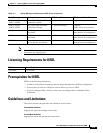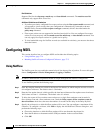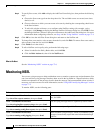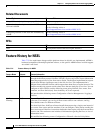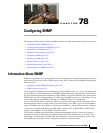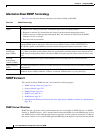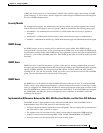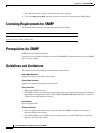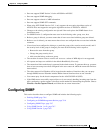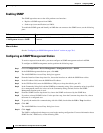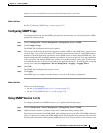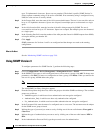
CHAPTER
78-1
Cisco ASA 5500 Series Configuration Guide using ASDM
78
Configuring SNMP
This chapter describes how to configure SNMP to monitor the ASA and includes the following sections:
• Information About SNMP, page 78-1
• Licensing Requirements for SNMP, page 78-4
• Prerequisites for SNMP, page 78-4
• Guidelines and Limitations, page 78-4
• Configuring SNMP, page 78-5
• Monitoring SNMP, page 78-9
• Where to Go Next, page 78-10
• Additional References, page 78-10
• Feature History for SNMP, page 78-13
Information About SNMP
SNMP is an application-layer protocol that facilitates the exchange of management information between
network devices and is part of the TCP/IP protocol suite. This section describes SNMP and includes the
following topics:
• Information About SNMP Terminology, page 78-2
• SNMP Version 3, page 78-2
The ASA provides support for network monitoring using SNMP Versions 1, 2c, and 3, and supports the
use of all three versions simultaneously. The SNMP agent running on the ASA interface lets you monitor
the ASA and through network management systems (NMSs), such as HP OpenView. The ASA supports
SNMP read-only access through issuance of a GET request. SNMP write access is not allowed, so you
cannot make changes with SNMP. In addition, the SNMP SET request is not supported.
You can configure the ASA to send traps, which are unsolicited messages from the managed device to
the management station for certain events (event notifications) to an NMS, or you can use the NMS to
browse the MIBs on the ASA. MIBs are a collection of definitions, and the ASA maintains a database
of values for each definition. Browsing a MIB means issuing a series of GET-NEXT or GET-BULK
requests of the MIB tree from the NMS to determine values.
The ASA has an SNMP agent that notifies designated management stations if events occur that are
predefined to require a notification, for example, when a link in the network goes up or down. The
notification it sends includes an SNMP OID, which identifies itself to the management stations. The
ASASNMP agent also replies when a management station asks for information.



